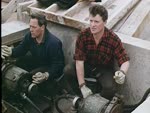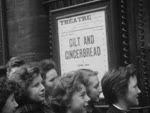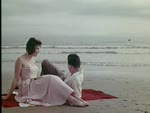SHE BLAZED A TRAIL
Full length video
Please read Understanding catalogue records for help interpreting this information and Using footage for more information about accessing this film.
Title: SHE BLAZED A TRAIL
Reference number: 4133
Date: 1963*
Production company: Gateway Films
Sound: sound
Original format: 16mm
Colour: col
Fiction: non-fiction
Running time: 30.13 mins
Description: The life and times of Church of Scotland missionary Mary Slessor. Her work in Africa and the lives she saved through religion and hospital care.
Credits:
film ed. & sc. Hugh Baddeley
ph. in Scotland Graham Smart
ph. in Nigeria Raymond Wood & Austin Sparke
comm.s. Marjorie Dalziel
artwork, African scenes Ian Armour-Chelu
Shotlist: Title superimposed over shot of a church? (0.11); clock showing six o'clock, bell ringing in tower, shot of people as they run over cobbled street (0.26); shot of a woman working a loom in a factory, woman reading book (playing part of Mary Slessor) (1.05); sketch of Belmont Street Church in Aberdeen (1.13); sketch of Mutton Brae Street (now demolished) (1.24); Shot of Mary's home in Dundee (1.33); sign for Baxter Brothers & Co. Ltd. Dens Work (1.36); woman working loom in the mill (1.52); woman reading as she works (2.06); Wishart Church (2.09); Missionary Record of the United Presbyterian Church, dated May 2, 1859. Page on Africa, Calabar (2.30); picture of Livingstone (2.46); picture of Mary Slessor (2.58); a letter being written (3.13); picture of a steam ship (3.18); map of Mary's journey from Scotland to Calabar (3.24); Shots of Calabar and daily life (4.23); shot of church in Calabar (4.23); drawing of Mary with African children (4.35); shot of church and the school with the children (4.49); gvs of Calabar, shots showing the different cultures which existed such as voodoo, cannibalism, witch doctors etc. (6.25); shot of a drawing of the people and their justice system that Mary worked with (7.09); picture of Mary (7.18); shot of the king that Mary was friends with (7.35); man rowing a canoe (8.26); shots of Mary in the village, with the people and the Chief (9.18); Shot of an extract from a letter. Page in her Bible on which she wrote "God and one are always a majority" (9.43); men building materials for a house, drawing of Mary's house with the villagers standing outside (10.50); Mary photographed with other missionaries (11.03); Mary's two storey house (11.08); Pots used for the bodies of twins (11.27); Mary pictured with the twins she saved (11.52); gvs of Akpap, Mary's house and the villagers (13.00); Drawings of the Arrow people, shot of the slave market (14.41); Map of Nigeria, Calabar River with the towns that Mary had visited (15.25); gvs of ITU and Mary, interview with one of the twins that she saved, gvs of Itu ceremony, shots of Mary and those that she helped. Shots of villages and hospitals, churches and schools that she pioneered (25.00); pictures of Mary from a young woman to just before she died (she died 13th January 1915) (26.50); shot of Mary's gravestone in Calabar (27.05); The Queen laid a wreath at her grave in 1956 (27.16); Shot of a bus donated by Aberdeen, shot of Dundee city skyline, Nigerian University, City Museum, gvs of modern Nigeria, industry etc.






